As I stood in my kitchen, the aroma of sizzling chicken filled the air, instantly transporting me to the vibrant streets of Seoul. It’s hard to resist the allure of Korean Chicken Bao, with its soft, fluffy buns cradling crisp chicken coated in a spicy gochujang sauce. This recipe is not just about indulging in deliciousness; it’s a charming crowd-pleaser, perfect for gatherings or a cozy night in. Plus, the option to make-ahead adds to its charm, allowing you to savor homemade comfort without the last-minute rush. Who wouldn’t love a twist on traditional street food that brings joy and warmth to the table? Get ready to fill your kitchen with delightful scents and impress your loved ones with these delectable bao buns! Are you ready to dive into this culinary adventure?
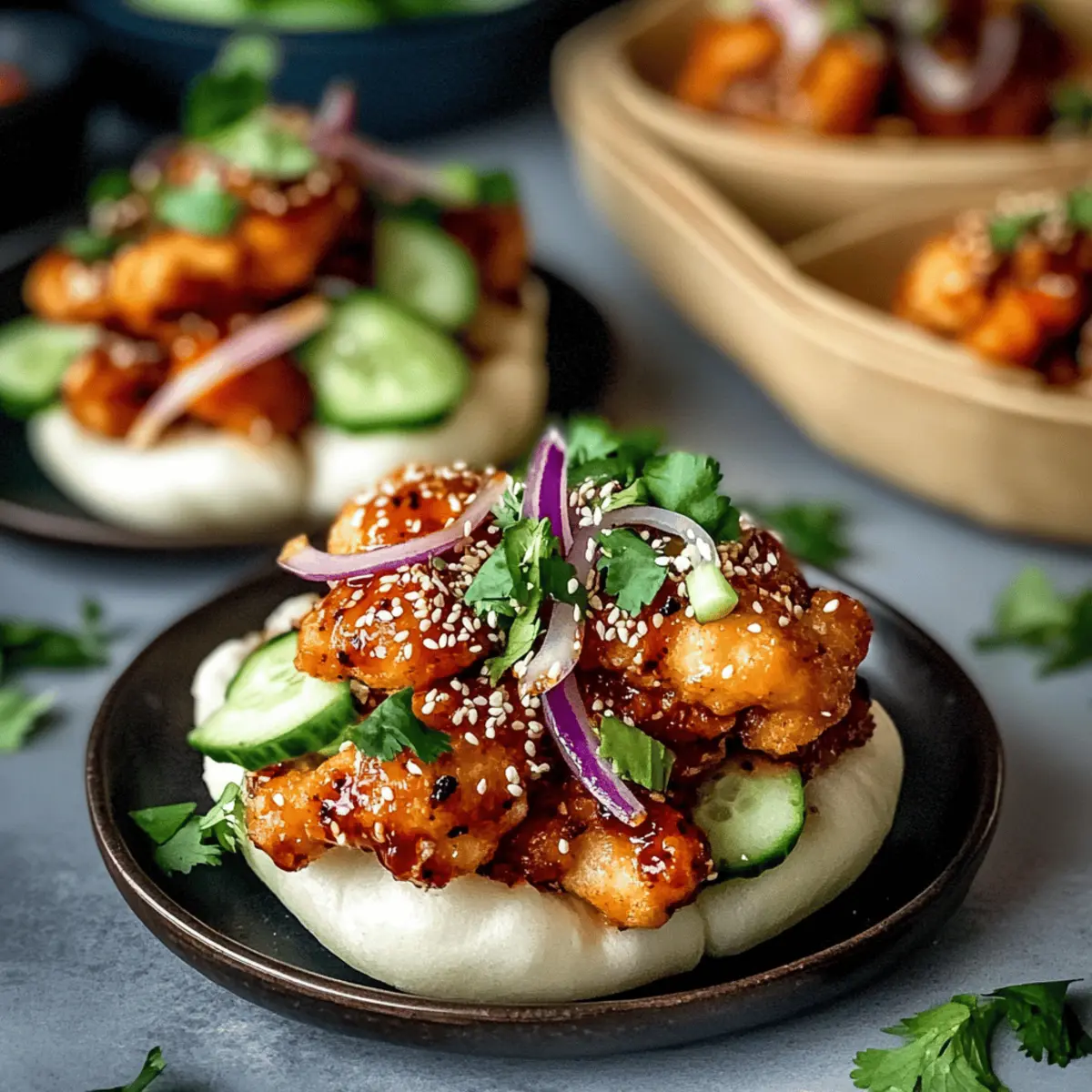
Why Is Korean Chicken Bao So Irresistible?
Irresistible Aroma: As the chicken sizzles, the fragrant spices transport you right to a bustling street market.
Fluffy Perfection: The soft bao buns create a comforting hug around the crispy chicken, making each bite a delightful experience.
Flavor Explosion: A tantalizing balance of spicy gochujang and sweet honey elevates the flavor profile to a whole new level.
Make-Ahead Magic: Prep and freeze your buns to enjoy this scrumptious dish whenever cravings hit, saving that precious time.
Crowd-Pleasing Appeal: Whether it’s game night or a cozy dinner, these bao buns will impress and satisfy your guests, just like my Garlic Parmesan Chicken.
Get ready to wow with this comfort food twist!
Korean Chicken Bao Ingredients
For the Bao Buns
• Plain (All-Purpose) Flour – Provides the structure for the bao. Substitution: For a gluten-free option, use a gluten-free all-purpose blend.
• Caster Sugar – Adds subtle sweetness to the dough. Substitution: Granulated sugar can be used, but a finer sugar will ensure better mixing.
• Salt – Enhances the overall flavor. Essential for balancing sweetness.
• Instant Dried Yeast – Leavening agent to make the buns fluffy. Note: Ensure it’s fresh for best results.
• Whole Milk – Adds richness to the dough. Substitution: Non-dairy milk can be used for a vegan alternative.
• Warm Water – Activates the yeast. Temperature should be around 110°F/43°C.
• Unsalted Butter – Adds moisture and flavor to the buns. Substitution: Use margarine for a dairy-free version.
• Olive Oil – Used for brushing the buns before steaming. Note: Can replace with melted butter for a richer flavor.
For the Chicken Filling
• Chicken Breasts – Main protein, packed with flavor when marinated. Preparation: Cut into bite-sized pieces for even cooking.
• Buttermilk – Tenderizes the chicken and adds a tangy flavor. Substitution: Mix milk with a splash of vinegar as a DIY buttermilk.
• Crispy Coating Flour Mix (Plain Flour, Salt, Black Pepper, Garlic Salt, Celery Salt, Thyme, Paprika, Baking Powder, Chilli Flakes) – Creates a seasoned crispy layer on the chicken. Notes: Adjust spices to preference for heat levels.
• Vegetable Oil – For deep frying, essential for crispiness. Ensure oil is hot enough before adding chicken.
For the Gochujang Sauce
• Gochujang Paste – Provides heat and umami flavor in the sauce. Note: Adjust quantity based on spice tolerance.
• Honey – Adds sweetness to the sauce. Substitution: Maple syrup could work for a similar sweetness.
• Brown Sugar – Contributes depth to the sauce flavor. Substitution: Coconut sugar can be used for a healthier option.
• Soy Sauce – Enhances the overall umami richness. Substitution: Tamari for gluten-free alternative.
• Garlic and Ginger – Essential aromatics for flavoring. Prep Note: Fresh is preferred, but powder can work in a pinch.
For Garnishing
• Red Onion, Cucumber, Fresh Coriander (Cilantro), Sesame Seeds – For garnishing and added freshness to each bao.
Dive into the deliciousness of these Korean Chicken Bao! Each ingredient plays a pivotal role in this flavor-packed delight, ensuring an unforgettable experience for every bite!
Step‑by‑Step Instructions for Korean Chicken Bao
Step 1: Prepare Bao Bun Dough
In a large mixing bowl, combine 4 cups of plain (all-purpose) flour, ¼ cup of caster sugar, 1 teaspoon of salt, and 2 teaspoons of instant dried yeast. Warm 1 cup of whole milk and ½ cup of warm water to about 110°F/43°C, then mix in 3 tablespoons of melted unsalted butter. Slowly add this mixture to the dry ingredients, kneading for about 10 minutes until smooth. Cover the bowl and let the dough rise for 90 minutes to 2 hours, or until it has doubled in size.
Step 2: Marinate Chicken
While the dough is proving, prepare the chicken by placing 1 pound of bite-sized chicken breast pieces in a bowl. Add 1 cup of buttermilk, 1 teaspoon of salt, and your crispy coating spices. Mix well to coat the chicken and refrigerate for at least 1 hour. This marination not only enhances the flavor but also tenderizes the chicken, ensuring it turns out juicy.
Step 3: Shape Buns
After the dough has risen, gently punch it down and divide it into 20 equal pieces. Roll each piece into an oval shape and brush with olive oil. Arrange the shaped buns on parchment-lined trays, cover them, and let them proof again for about 1 hour. When done, they should have increased in size and look puffy, ready to be steamed.
Step 4: Prepare Crispy Coating
In a separate bowl, mix your crispy coating ingredients which include 1 cup of plain flour, ½ teaspoon each of black pepper, garlic salt, celery salt, thyme, paprika, and chili flakes. Once your chicken has marinated, dredge each piece in the coating mixture, ensuring an even layer. This will create a beautifully crispy texture once fried.
Step 5: Fry Chicken
Heat about 2 inches of vegetable oil in a deep saucepan over medium-high heat until it reaches 350°F/175°C. Carefully add the coated chicken pieces in batches, being cautious not to overcrowd the pan. Fry for 3-5 minutes or until each piece is golden brown and cooked through. Transfer the fried chicken to a plate lined with paper towels to drain excess oil.
Step 6: Steam Bao Buns
Set up a steamer or a pot with a steaming rack and bring water to a gentle boil. Place the prepared bao buns in the steamer, ensuring they have space to expand. Steam for about 10 minutes, or until they are fluffy and slightly shiny. The soft and pillowy texture of these buns is essential for your Korean Chicken Bao.
Step 7: Make the Sauce
In a small saucepan, combine 2 tablespoons of gochujang paste, 2 tablespoons of honey, 1 tablespoon of brown sugar, 2 tablespoons of soy sauce, minced garlic, and grated ginger. Simmer the mixture over low heat for about 5 minutes, stirring continuously until it thickens slightly. This sweet and spicy sauce will elevate the flavor of your crispy chicken.
Step 8: Combine Chicken and Sauce
Once the chicken is fried and the sauce is ready, toss the crispy chicken pieces in the prepared sauce until they are well coated. Make sure each piece is covered in this vibrant gochujang mixture, allowing the flavors to meld together beautifully.
Step 9: Assemble Bao Buns
To serve, gently open the steamed bao buns and fill each one with the saucy Korean chicken. Top with sliced red onions, cucumber strips, and fresh coriander for a burst of color and flavor. Finally, sprinkle with sesame seeds to finish off your Korean Chicken Bao, making them a visually appealing and delicious treat!
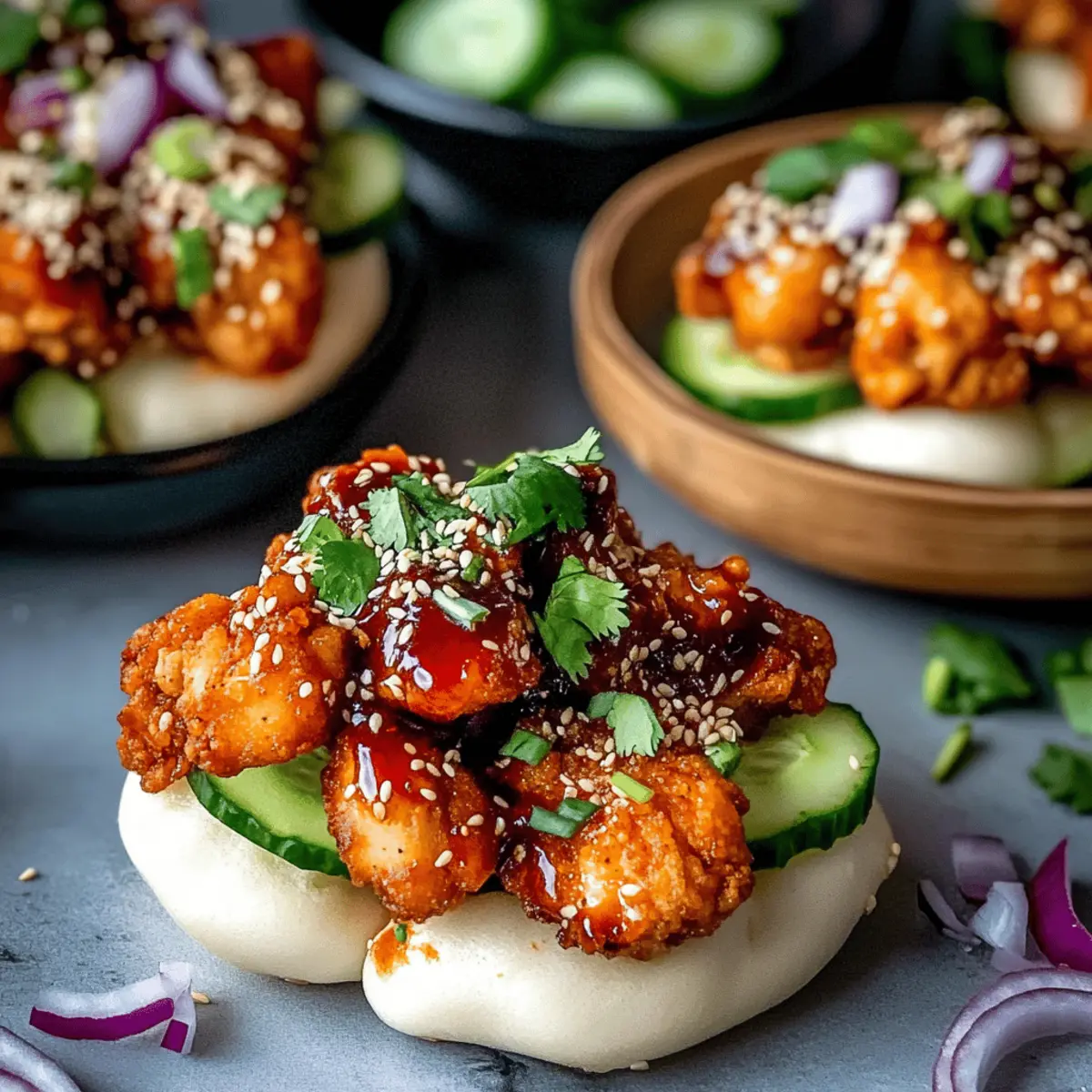
Make Ahead Options
These Korean Chicken Bao are a fantastic choice for busy home cooks looking to save time without sacrificing flavor! You can prepare the bao bun dough up to 24 hours in advance; simply complete the first rise, then refrigerate it. The chicken can be marinated in buttermilk and spices up to 3 days ahead, ensuring it’s packed with flavor while keeping it tender. To maintain the buns’ softness, freeze them after steaming and reheat by steaming again for about 10 minutes before serving. This way, you can whip out these delightful bao and have them ready — with minimal effort — for an incredible meal that feels just like freshly made!
Expert Tips for Korean Chicken Bao
-
Fresh Ingredients: Use fresh herbs and spices for the best flavor in your Korean Chicken Bao; they can significantly elevate the dish’s taste profile.
-
Perfect Dough: Knead the bao dough well to activate the gluten, which creates that tender and fluffy texture essential for delicious buns.
-
Avoid Sogginess: Always allow fried chicken to rest on paper towels to remove excess oil before adding it to the bao; this ensures a crispy bite.
-
Steam with Care: Make sure your steamer is hot before adding the buns; steaming too slowly can lead to dense, gummy bao.
-
Customize the Filling: Don’t be afraid to experiment with different fillings or sauce ratios in your Korean Chicken Bao; adjust to your taste preference for an even more personalized dish.
What to Serve with Korean Chicken Bao?
As you savor the delicious layers of flavor in your bao, consider these delightful accompaniments to create a full meal experience.
-
Crispy Asian Slaw: A crunchy, tangy slaw with sesame dressing complements the bao’s richness and adds a refreshing contrast.
-
Steamed Edamame: Lightly salted, these tender soybeans are a perfect finger food that adds an earthy bite to your meal.
-
Spicy Pickled Vegetables: The sharpness and heat from pickled veggies beautifully balance the savory bao, enhancing each bite.
-
Garlic Soy Dipping Sauce: A drizzle of this savory sauce brings another level of flavor to your bao, making every bite irresistible.
Pair these with a chilled Green Tea for a refreshing drink, or make the occasion sweeter with Mochi Ice Cream for dessert. Each of these additions enhances the overall experience, turning your meal into a delightful feast.
Korean Chicken Bao Customizations
Let your culinary creativity shine by customizing these delightful bao buns to suit your tastes!
-
Vegetarian Delight: Replace chicken with fried tofu or mushrooms, marinated in a similar sauce for a hearty twist. These options bring rich flavors and satisfy cravings while keeping it plant-based.
-
Milder Sauce: For those who prefer gentler flavors, swap gochujang paste with sweet chili sauce. This keeps the dish fun and accessible for all spice levels.
-
Healthier Baking: Instead of frying, bake the coated chicken in a preheated oven for a lighter option. Just drizzle a little oil before baking for that delicious crispiness without deep frying.
-
Whole Wheat Buns: Use whole wheat flour instead of all-purpose for a nutritious, nutty flavor in your bao buns. They’ll still be fluffy, but with an extra health kick!
-
Spicy Kick: Add chili garlic sauce or a sprinkle of cayenne pepper to the sauce for those who adore heat. It elevates the dish and gives your guests that spicy punch they’re hankering for.
-
Fusion Flavors: Take an adventurous leap by incorporating BBQ sauce along with the gochujang for a sweet and smoky flavor profile. It’s a unique take that will surprise and delight!
-
Substitution Fun: If you’re out of honey, don’t fret! Maple syrup or agave nectar can be a wonderful, plant-based alternative that still lends the needed sweetness.
Transform your traditional Korean Chicken Bao into a signature dish that reflects your taste, and don’t forget to check out my delicious Garlic Parmesan Chicken for another satisfying recipe that’ll ignite your passion for cooking!
Storage Tips for Korean Chicken Bao
-
Room Temperature: Korean Chicken Bao is best enjoyed fresh. If you have leftovers, keep them at room temperature for no more than 2 hours to ensure food safety.
-
Fridge: You can refrigerate the bao and chicken filling separately for up to 3 days. Store the chicken in an airtight container to maintain its flavor and moisture.
-
Freezer: For longer storage, freeze the cooled bao buns and crispy chicken in airtight bags for up to 3 months. When ready to enjoy, thaw overnight in the fridge and reheat by steaming.
-
Reheating: To regain that delicious crispiness of the chicken, reheat by placing it in a hot oven for about 10 minutes. Steamed buns can be reheated in the steamer or microwave for soft, fluffy results.
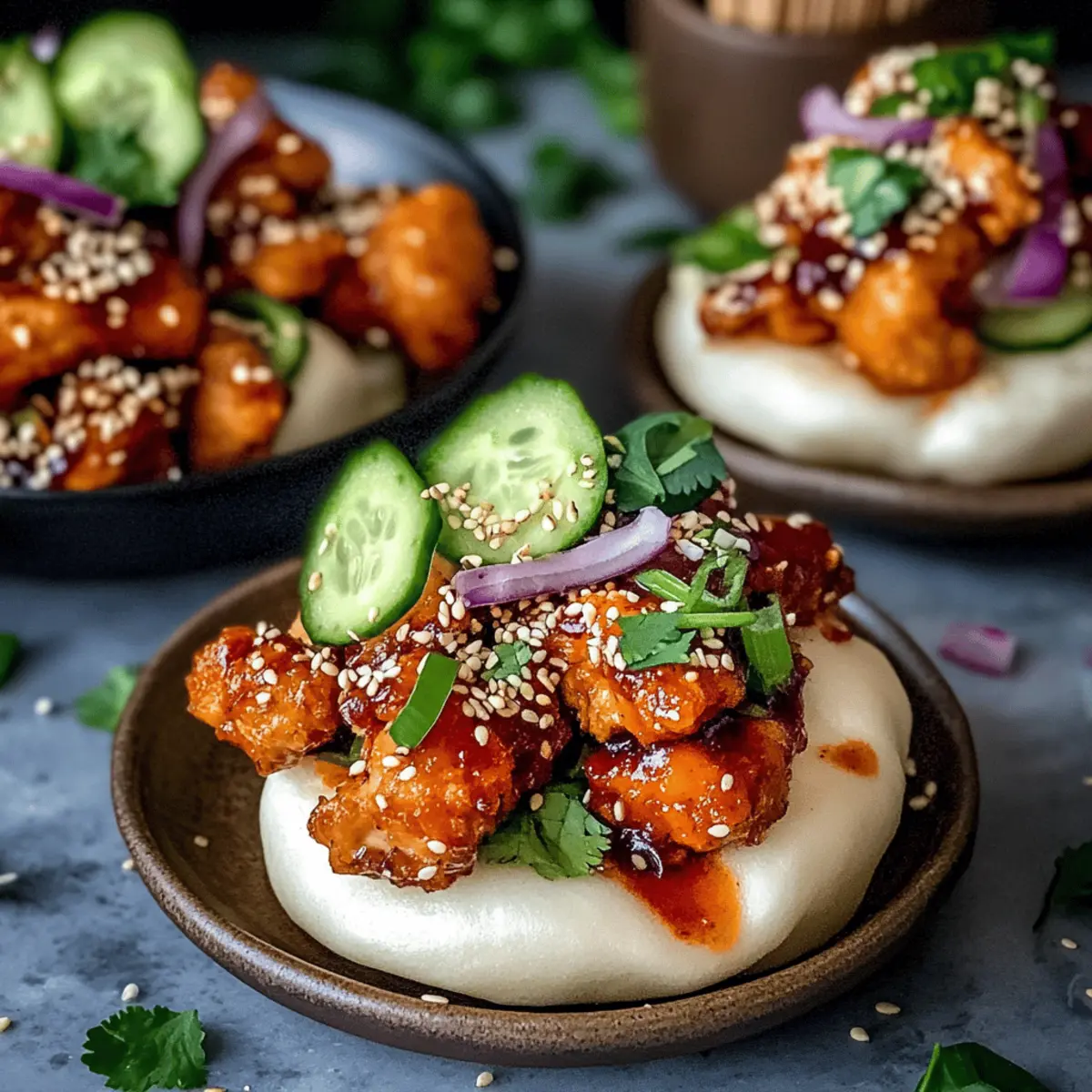
Korean Chicken Bao Recipe FAQs
How do I choose the right ingredients for the bao buns?
Absolutely! When selecting ingredients, fresh all-purpose flour and instant dried yeast are crucial for achieving that perfect fluffy texture. Be sure your yeast is fresh; if it doesn’t bubble when activated, it may not leaven the dough properly. The milk should be warm (around 110°F/43°C) to activate the yeast effectively. If you’re opting for gluten-free, look for a reliable gluten-free all-purpose blend.
What’s the best way to store leftover bao buns?
The more the merrier! If you have leftovers, store the bao buns and chicken filling separately. In the fridge, they’ll be good for up to 3 days in airtight containers. If you’re looking for long-term storage, freeze them in airtight bags for up to 3 months. Just make sure to seal out as much air as possible to maintain their quality!
Can I freeze the Korean Chicken Bao? If so, how?
Yes, absolutely! To freeze, allow the bao buns and crispy chicken to cool completely after cooking. Once cooled, place them in separate airtight bags, removing as much air as possible. They can be stored in the freezer for up to 3 months. When you’re ready to enjoy them, simply thaw the buns in the fridge overnight and reheat the chicken in a preheated oven or skillet to regain its crunch.
What if my bao buns turn out dense or gummy?
Very common! To avoid dense or gummy bao buns, ensure that your dough is kneaded enough to develop gluten — typically about 10 minutes. Make sure to let the dough rise until it has doubled in size, usually taking about 90 minutes to 2 hours. Also, ensure your steamer is preheated and the buns aren’t overcrowded, as this allows them space to expand and cook evenly.
Are Korean Chicken Bao suitable for people with dietary restrictions?
Absolutely! If you have dietary restrictions, there are plenty of substitutions. Use non-dairy milk and margarine for dairy-free alternatives in the dough. For those avoiding gluten, substitute with a gluten-free flour blend for the buns and use tamari sauce instead of soy sauce. You can also make these bao vegetarian by replacing the chicken with fried tofu or hearty mushrooms marinated in the same flavorful blend!
How long do fresh ingredients really last, and what’s the que for spoilage?
When stored properly, fresh ginger and garlic can last in the fridge for up to 2-3 weeks. However, be cautious of mold or sprouting; if you see these, it’s best to discard. Fresh produce like cucumbers and cilantro should be used within a week for the best taste. If your ingredients are starting to wilt or show dark spots, it’s time to get creative and use them up!
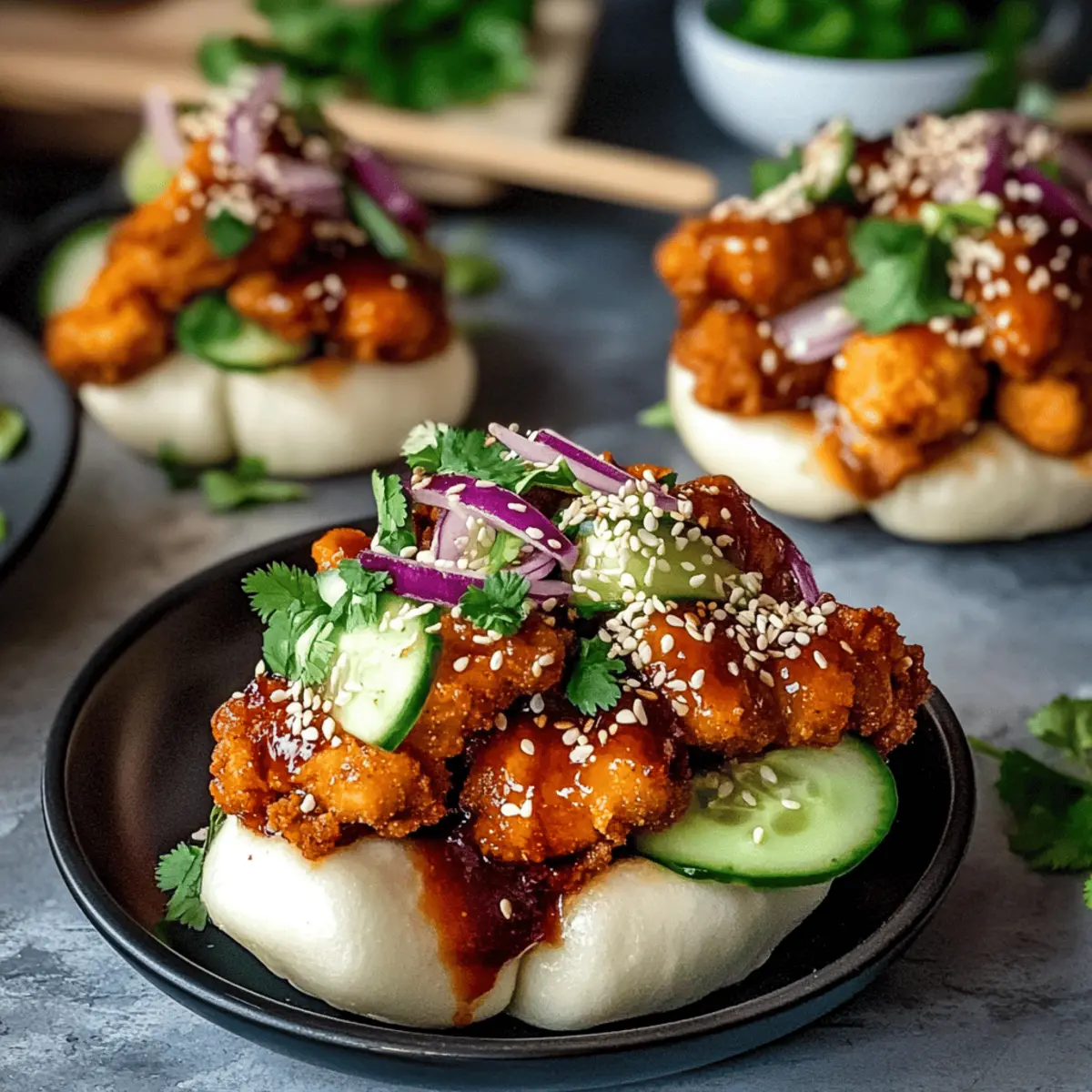
Crispy Korean Chicken Bao for Flavor-Packed Delight
Ingredients
Equipment
Method
- In a large mixing bowl, combine 4 cups of plain (all-purpose) flour, ¼ cup of caster sugar, 1 teaspoon of salt, and 2 teaspoons of instant dried yeast. Warm 1 cup of whole milk and ½ cup of warm water to about 110°F/43°C, then mix in 3 tablespoons of melted unsalted butter. Slowly add this mixture to the dry ingredients, kneading for about 10 minutes until smooth. Cover the bowl and let the dough rise for 90 minutes to 2 hours, or until it has doubled in size.
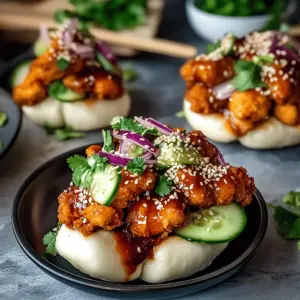
- While the dough is proving, prepare the chicken by placing 1 pound of bite-sized chicken breast pieces in a bowl. Add 1 cup of buttermilk, 1 teaspoon of salt, and your crispy coating spices. Mix well to coat the chicken and refrigerate for at least 1 hour.

- After the dough has risen, gently punch it down and divide it into 20 equal pieces. Roll each piece into an oval shape and brush with olive oil. Arrange the shaped buns on parchment-lined trays, cover them, and let them proof again for about 1 hour.

- In a separate bowl, mix your crispy coating ingredients which include 1 cup of plain flour, ½ teaspoon each of black pepper, garlic salt, celery salt, thyme, paprika, and chili flakes. Once your chicken has marinated, dredge each piece in the coating mixture, ensuring an even layer.

- Heat about 2 inches of vegetable oil in a deep saucepan over medium-high heat until it reaches 350°F/175°C. Carefully add the coated chicken pieces in batches, and fry for 3-5 minutes or until each piece is golden brown and cooked through.

- Set up a steamer or pot with a steaming rack and bring water to a gentle boil. Place the prepared bao buns in the steamer, ensuring they have space to expand. Steam for about 10 minutes, until they are fluffy and slightly shiny.

- In a small saucepan, combine 2 tablespoons of gochujang paste, 2 tablespoons of honey, 1 tablespoon of brown sugar, 2 tablespoons of soy sauce, minced garlic, and grated ginger. Simmer over low heat for about 5 minutes until it thickens slightly.

- Once the chicken is fried and the sauce is ready, toss the crispy chicken pieces in the prepared sauce until well coated.

- To serve, gently open the steamed bao buns and fill each one with the saucy Korean chicken. Top with sliced red onions, cucumber strips, and fresh coriander for flavor.


Leave a Reply